Reflection in Action: Analysis of a Nursing Placement Experience
VerifiedAdded on 2019/11/12
|6
|1502
|165
Report
AI Summary
This report presents a reflective account of a nursing student's experience in a mental health ward. The student recounts an incident involving a 25-year-old patient, Sarah, admitted after a suicide attempt due to bipolar disorder and personal issues. The narrative details the student's initial fear and apprehension in handling aggressive patients and those at risk of self-harm. The report analyzes the student's actions, including the use of restraints, and the subsequent guidance received from a senior nurse. It highlights the importance of calm communication, understanding patient behavior, and the application of appropriate interventions. The reflection emphasizes the student's growth in overcoming phobias, developing critical thinking skills, and improving patient care practices in mental health settings. The report references key literature on nursing practices, including patient safety, therapeutic communication and handling difficult patients.
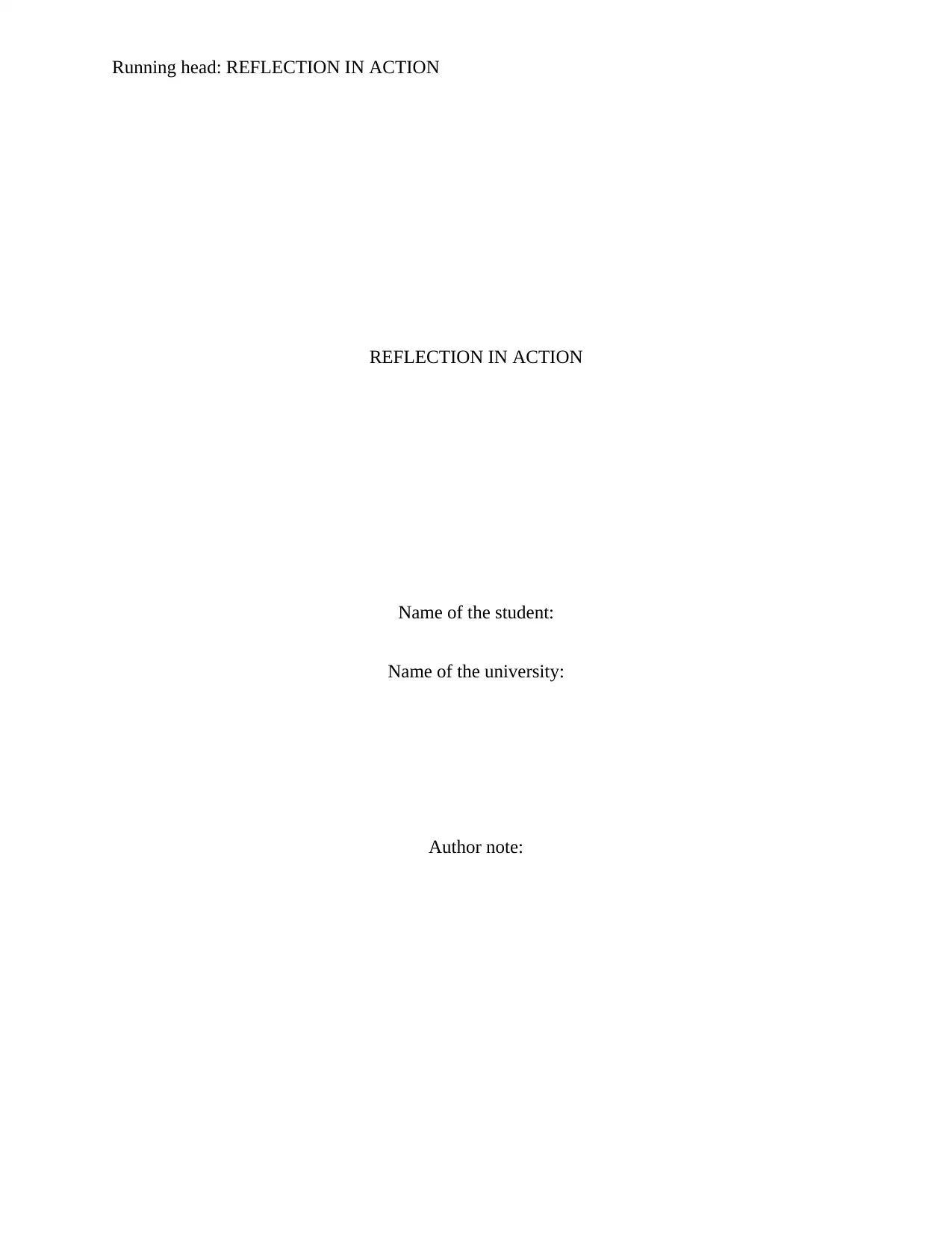
Running head: REFLECTION IN ACTION
REFLECTION IN ACTION
Name of the student:
Name of the university:
Author note:
REFLECTION IN ACTION
Name of the student:
Name of the university:
Author note:
Paraphrase This Document
Need a fresh take? Get an instant paraphrase of this document with our AI Paraphraser
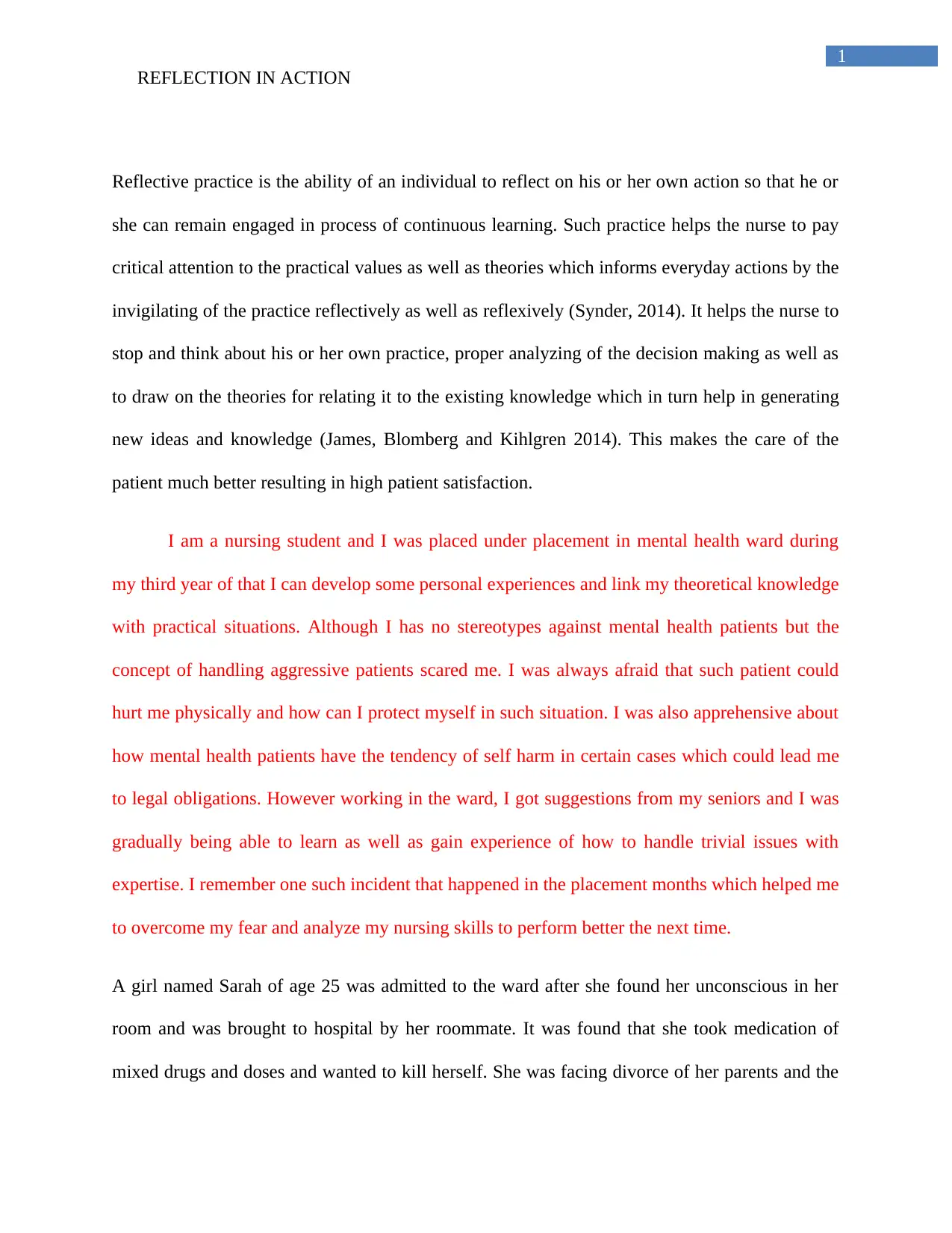
1
REFLECTION IN ACTION
Reflective practice is the ability of an individual to reflect on his or her own action so that he or
she can remain engaged in process of continuous learning. Such practice helps the nurse to pay
critical attention to the practical values as well as theories which informs everyday actions by the
invigilating of the practice reflectively as well as reflexively (Synder, 2014). It helps the nurse to
stop and think about his or her own practice, proper analyzing of the decision making as well as
to draw on the theories for relating it to the existing knowledge which in turn help in generating
new ideas and knowledge (James, Blomberg and Kihlgren 2014). This makes the care of the
patient much better resulting in high patient satisfaction.
I am a nursing student and I was placed under placement in mental health ward during
my third year of that I can develop some personal experiences and link my theoretical knowledge
with practical situations. Although I has no stereotypes against mental health patients but the
concept of handling aggressive patients scared me. I was always afraid that such patient could
hurt me physically and how can I protect myself in such situation. I was also apprehensive about
how mental health patients have the tendency of self harm in certain cases which could lead me
to legal obligations. However working in the ward, I got suggestions from my seniors and I was
gradually being able to learn as well as gain experience of how to handle trivial issues with
expertise. I remember one such incident that happened in the placement months which helped me
to overcome my fear and analyze my nursing skills to perform better the next time.
A girl named Sarah of age 25 was admitted to the ward after she found her unconscious in her
room and was brought to hospital by her roommate. It was found that she took medication of
mixed drugs and doses and wanted to kill herself. She was facing divorce of her parents and the
REFLECTION IN ACTION
Reflective practice is the ability of an individual to reflect on his or her own action so that he or
she can remain engaged in process of continuous learning. Such practice helps the nurse to pay
critical attention to the practical values as well as theories which informs everyday actions by the
invigilating of the practice reflectively as well as reflexively (Synder, 2014). It helps the nurse to
stop and think about his or her own practice, proper analyzing of the decision making as well as
to draw on the theories for relating it to the existing knowledge which in turn help in generating
new ideas and knowledge (James, Blomberg and Kihlgren 2014). This makes the care of the
patient much better resulting in high patient satisfaction.
I am a nursing student and I was placed under placement in mental health ward during
my third year of that I can develop some personal experiences and link my theoretical knowledge
with practical situations. Although I has no stereotypes against mental health patients but the
concept of handling aggressive patients scared me. I was always afraid that such patient could
hurt me physically and how can I protect myself in such situation. I was also apprehensive about
how mental health patients have the tendency of self harm in certain cases which could lead me
to legal obligations. However working in the ward, I got suggestions from my seniors and I was
gradually being able to learn as well as gain experience of how to handle trivial issues with
expertise. I remember one such incident that happened in the placement months which helped me
to overcome my fear and analyze my nursing skills to perform better the next time.
A girl named Sarah of age 25 was admitted to the ward after she found her unconscious in her
room and was brought to hospital by her roommate. It was found that she took medication of
mixed drugs and doses and wanted to kill herself. She was facing divorce of her parents and the
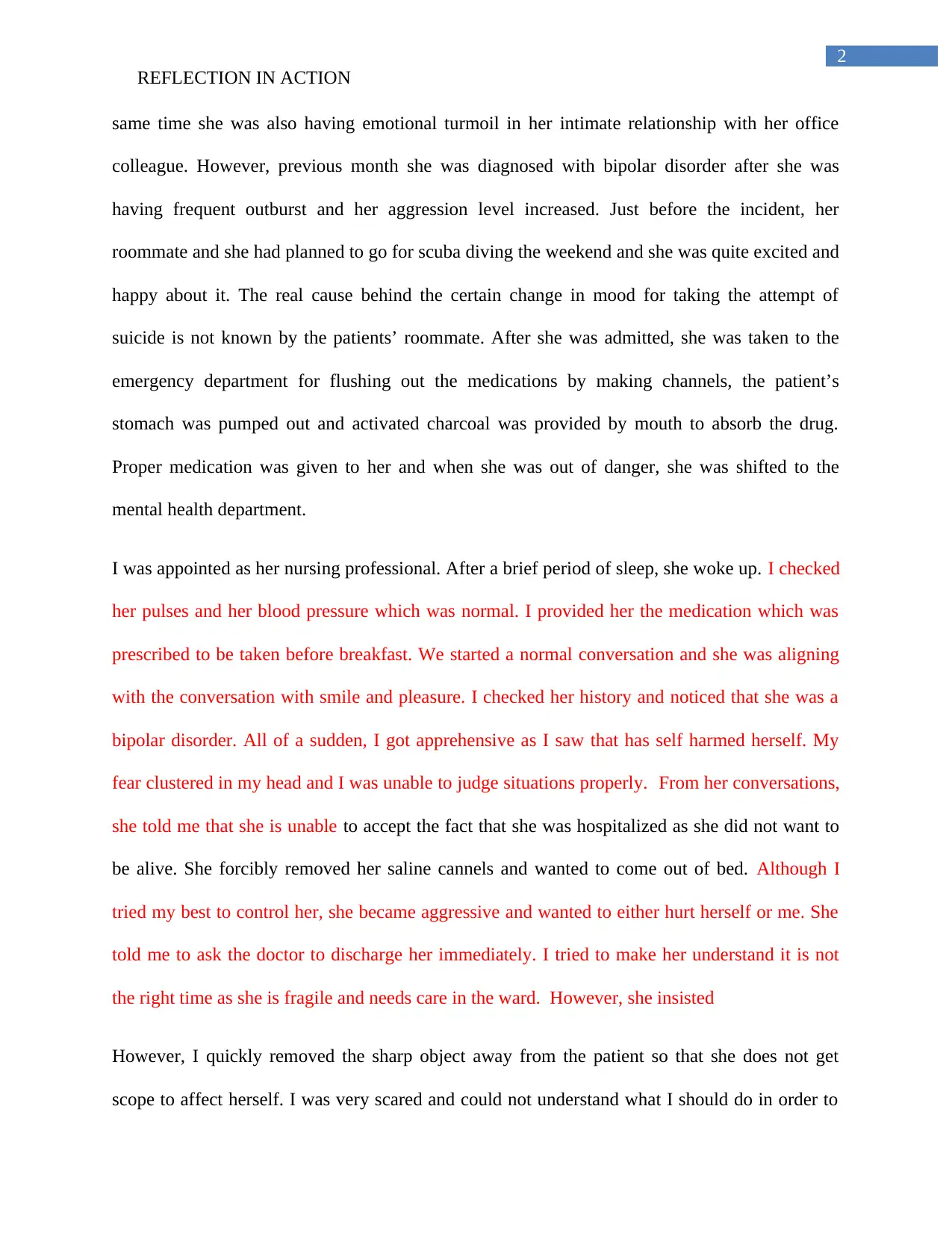
2
REFLECTION IN ACTION
same time she was also having emotional turmoil in her intimate relationship with her office
colleague. However, previous month she was diagnosed with bipolar disorder after she was
having frequent outburst and her aggression level increased. Just before the incident, her
roommate and she had planned to go for scuba diving the weekend and she was quite excited and
happy about it. The real cause behind the certain change in mood for taking the attempt of
suicide is not known by the patients’ roommate. After she was admitted, she was taken to the
emergency department for flushing out the medications by making channels, the patient’s
stomach was pumped out and activated charcoal was provided by mouth to absorb the drug.
Proper medication was given to her and when she was out of danger, she was shifted to the
mental health department.
I was appointed as her nursing professional. After a brief period of sleep, she woke up. I checked
her pulses and her blood pressure which was normal. I provided her the medication which was
prescribed to be taken before breakfast. We started a normal conversation and she was aligning
with the conversation with smile and pleasure. I checked her history and noticed that she was a
bipolar disorder. All of a sudden, I got apprehensive as I saw that has self harmed herself. My
fear clustered in my head and I was unable to judge situations properly. From her conversations,
she told me that she is unable to accept the fact that she was hospitalized as she did not want to
be alive. She forcibly removed her saline cannels and wanted to come out of bed. Although I
tried my best to control her, she became aggressive and wanted to either hurt herself or me. She
told me to ask the doctor to discharge her immediately. I tried to make her understand it is not
the right time as she is fragile and needs care in the ward. However, she insisted
However, I quickly removed the sharp object away from the patient so that she does not get
scope to affect herself. I was very scared and could not understand what I should do in order to
REFLECTION IN ACTION
same time she was also having emotional turmoil in her intimate relationship with her office
colleague. However, previous month she was diagnosed with bipolar disorder after she was
having frequent outburst and her aggression level increased. Just before the incident, her
roommate and she had planned to go for scuba diving the weekend and she was quite excited and
happy about it. The real cause behind the certain change in mood for taking the attempt of
suicide is not known by the patients’ roommate. After she was admitted, she was taken to the
emergency department for flushing out the medications by making channels, the patient’s
stomach was pumped out and activated charcoal was provided by mouth to absorb the drug.
Proper medication was given to her and when she was out of danger, she was shifted to the
mental health department.
I was appointed as her nursing professional. After a brief period of sleep, she woke up. I checked
her pulses and her blood pressure which was normal. I provided her the medication which was
prescribed to be taken before breakfast. We started a normal conversation and she was aligning
with the conversation with smile and pleasure. I checked her history and noticed that she was a
bipolar disorder. All of a sudden, I got apprehensive as I saw that has self harmed herself. My
fear clustered in my head and I was unable to judge situations properly. From her conversations,
she told me that she is unable to accept the fact that she was hospitalized as she did not want to
be alive. She forcibly removed her saline cannels and wanted to come out of bed. Although I
tried my best to control her, she became aggressive and wanted to either hurt herself or me. She
told me to ask the doctor to discharge her immediately. I tried to make her understand it is not
the right time as she is fragile and needs care in the ward. However, she insisted
However, I quickly removed the sharp object away from the patient so that she does not get
scope to affect herself. I was very scared and could not understand what I should do in order to
⊘ This is a preview!⊘
Do you want full access?
Subscribe today to unlock all pages.

Trusted by 1+ million students worldwide
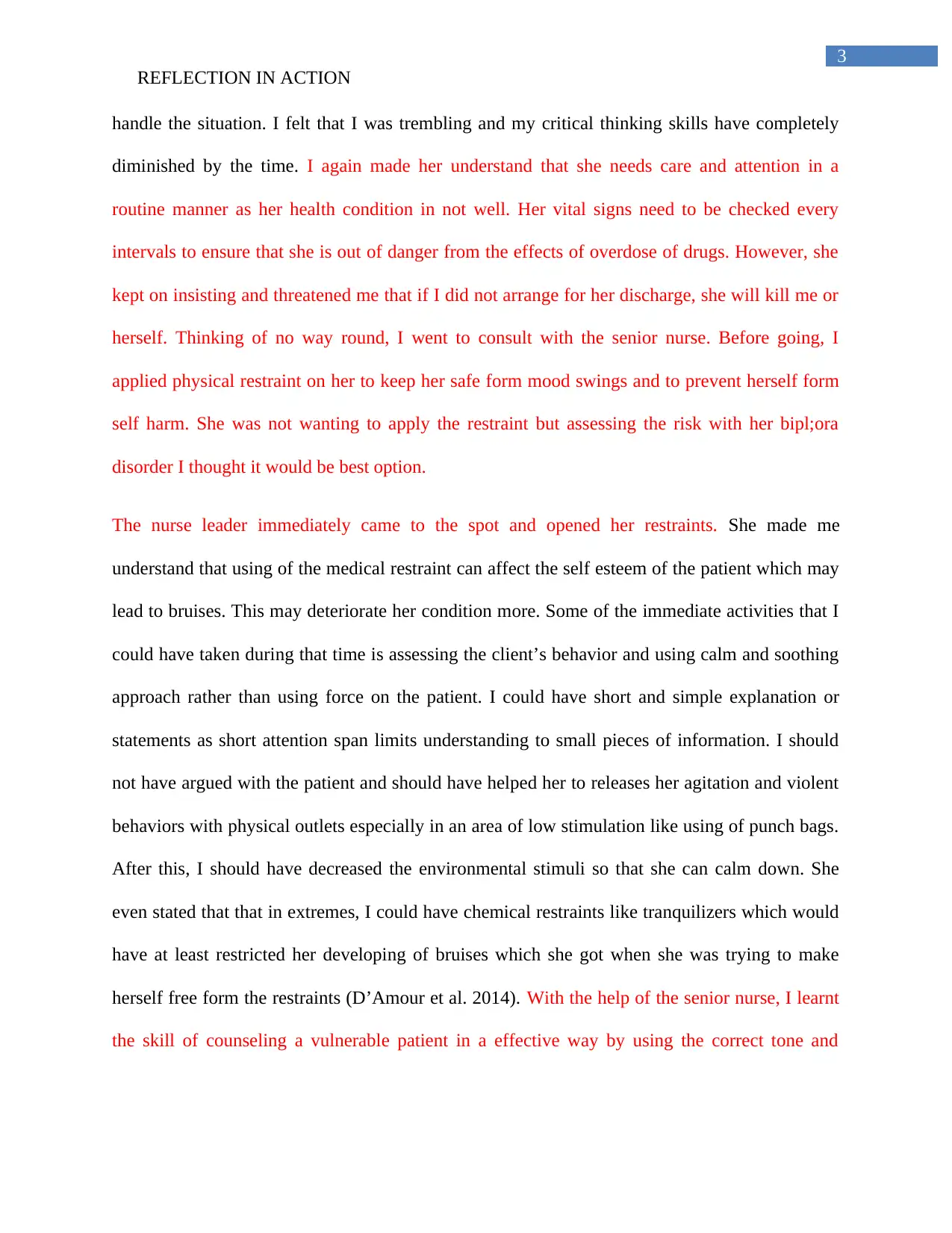
3
REFLECTION IN ACTION
handle the situation. I felt that I was trembling and my critical thinking skills have completely
diminished by the time. I again made her understand that she needs care and attention in a
routine manner as her health condition in not well. Her vital signs need to be checked every
intervals to ensure that she is out of danger from the effects of overdose of drugs. However, she
kept on insisting and threatened me that if I did not arrange for her discharge, she will kill me or
herself. Thinking of no way round, I went to consult with the senior nurse. Before going, I
applied physical restraint on her to keep her safe form mood swings and to prevent herself form
self harm. She was not wanting to apply the restraint but assessing the risk with her bipl;ora
disorder I thought it would be best option.
The nurse leader immediately came to the spot and opened her restraints. She made me
understand that using of the medical restraint can affect the self esteem of the patient which may
lead to bruises. This may deteriorate her condition more. Some of the immediate activities that I
could have taken during that time is assessing the client’s behavior and using calm and soothing
approach rather than using force on the patient. I could have short and simple explanation or
statements as short attention span limits understanding to small pieces of information. I should
not have argued with the patient and should have helped her to releases her agitation and violent
behaviors with physical outlets especially in an area of low stimulation like using of punch bags.
After this, I should have decreased the environmental stimuli so that she can calm down. She
even stated that that in extremes, I could have chemical restraints like tranquilizers which would
have at least restricted her developing of bruises which she got when she was trying to make
herself free form the restraints (D’Amour et al. 2014). With the help of the senior nurse, I learnt
the skill of counseling a vulnerable patient in a effective way by using the correct tone and
REFLECTION IN ACTION
handle the situation. I felt that I was trembling and my critical thinking skills have completely
diminished by the time. I again made her understand that she needs care and attention in a
routine manner as her health condition in not well. Her vital signs need to be checked every
intervals to ensure that she is out of danger from the effects of overdose of drugs. However, she
kept on insisting and threatened me that if I did not arrange for her discharge, she will kill me or
herself. Thinking of no way round, I went to consult with the senior nurse. Before going, I
applied physical restraint on her to keep her safe form mood swings and to prevent herself form
self harm. She was not wanting to apply the restraint but assessing the risk with her bipl;ora
disorder I thought it would be best option.
The nurse leader immediately came to the spot and opened her restraints. She made me
understand that using of the medical restraint can affect the self esteem of the patient which may
lead to bruises. This may deteriorate her condition more. Some of the immediate activities that I
could have taken during that time is assessing the client’s behavior and using calm and soothing
approach rather than using force on the patient. I could have short and simple explanation or
statements as short attention span limits understanding to small pieces of information. I should
not have argued with the patient and should have helped her to releases her agitation and violent
behaviors with physical outlets especially in an area of low stimulation like using of punch bags.
After this, I should have decreased the environmental stimuli so that she can calm down. She
even stated that that in extremes, I could have chemical restraints like tranquilizers which would
have at least restricted her developing of bruises which she got when she was trying to make
herself free form the restraints (D’Amour et al. 2014). With the help of the senior nurse, I learnt
the skill of counseling a vulnerable patient in a effective way by using the correct tone and
Paraphrase This Document
Need a fresh take? Get an instant paraphrase of this document with our AI Paraphraser
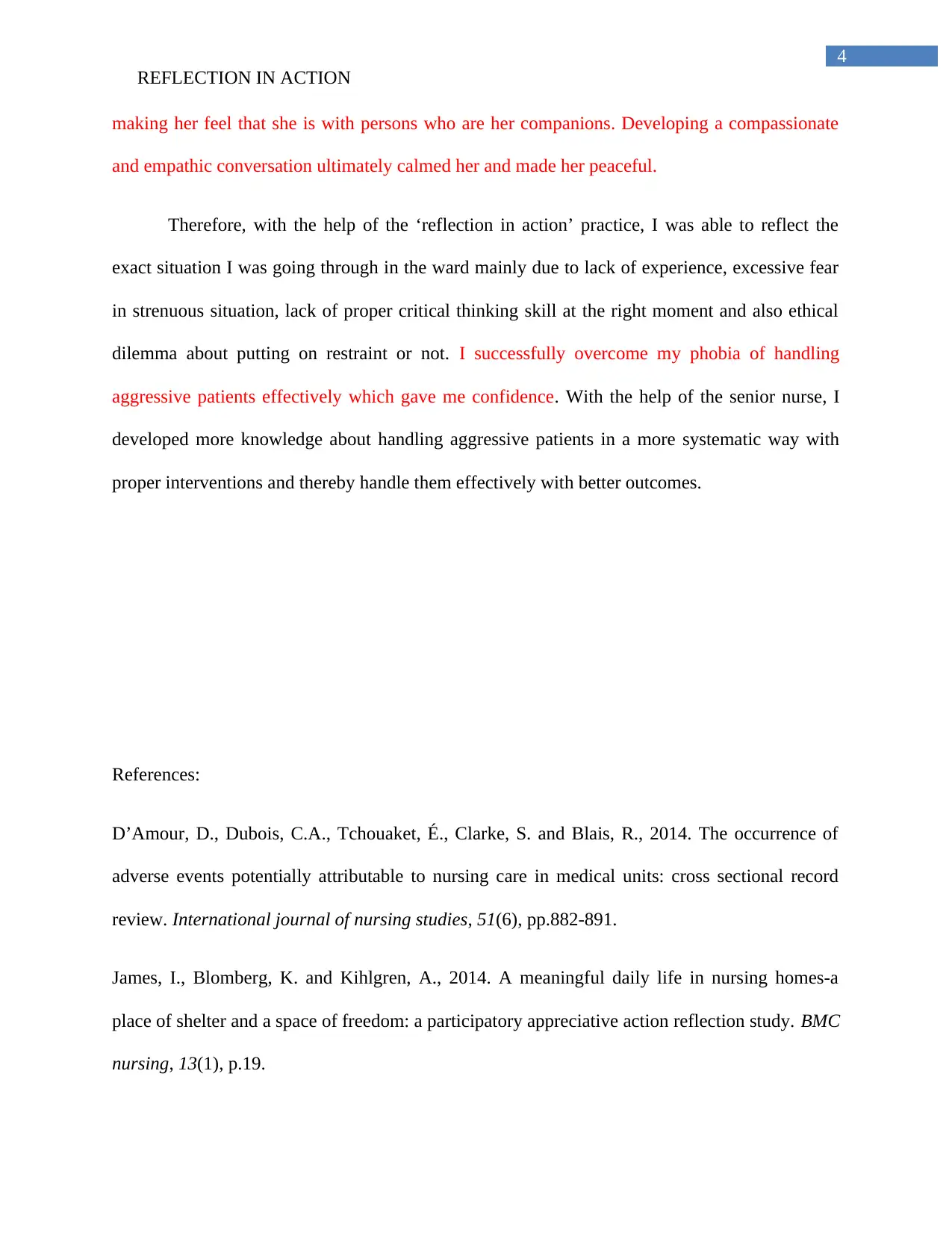
4
REFLECTION IN ACTION
making her feel that she is with persons who are her companions. Developing a compassionate
and empathic conversation ultimately calmed her and made her peaceful.
Therefore, with the help of the ‘reflection in action’ practice, I was able to reflect the
exact situation I was going through in the ward mainly due to lack of experience, excessive fear
in strenuous situation, lack of proper critical thinking skill at the right moment and also ethical
dilemma about putting on restraint or not. I successfully overcome my phobia of handling
aggressive patients effectively which gave me confidence. With the help of the senior nurse, I
developed more knowledge about handling aggressive patients in a more systematic way with
proper interventions and thereby handle them effectively with better outcomes.
References:
D’Amour, D., Dubois, C.A., Tchouaket, É., Clarke, S. and Blais, R., 2014. The occurrence of
adverse events potentially attributable to nursing care in medical units: cross sectional record
review. International journal of nursing studies, 51(6), pp.882-891.
James, I., Blomberg, K. and Kihlgren, A., 2014. A meaningful daily life in nursing homes-a
place of shelter and a space of freedom: a participatory appreciative action reflection study. BMC
nursing, 13(1), p.19.
REFLECTION IN ACTION
making her feel that she is with persons who are her companions. Developing a compassionate
and empathic conversation ultimately calmed her and made her peaceful.
Therefore, with the help of the ‘reflection in action’ practice, I was able to reflect the
exact situation I was going through in the ward mainly due to lack of experience, excessive fear
in strenuous situation, lack of proper critical thinking skill at the right moment and also ethical
dilemma about putting on restraint or not. I successfully overcome my phobia of handling
aggressive patients effectively which gave me confidence. With the help of the senior nurse, I
developed more knowledge about handling aggressive patients in a more systematic way with
proper interventions and thereby handle them effectively with better outcomes.
References:
D’Amour, D., Dubois, C.A., Tchouaket, É., Clarke, S. and Blais, R., 2014. The occurrence of
adverse events potentially attributable to nursing care in medical units: cross sectional record
review. International journal of nursing studies, 51(6), pp.882-891.
James, I., Blomberg, K. and Kihlgren, A., 2014. A meaningful daily life in nursing homes-a
place of shelter and a space of freedom: a participatory appreciative action reflection study. BMC
nursing, 13(1), p.19.
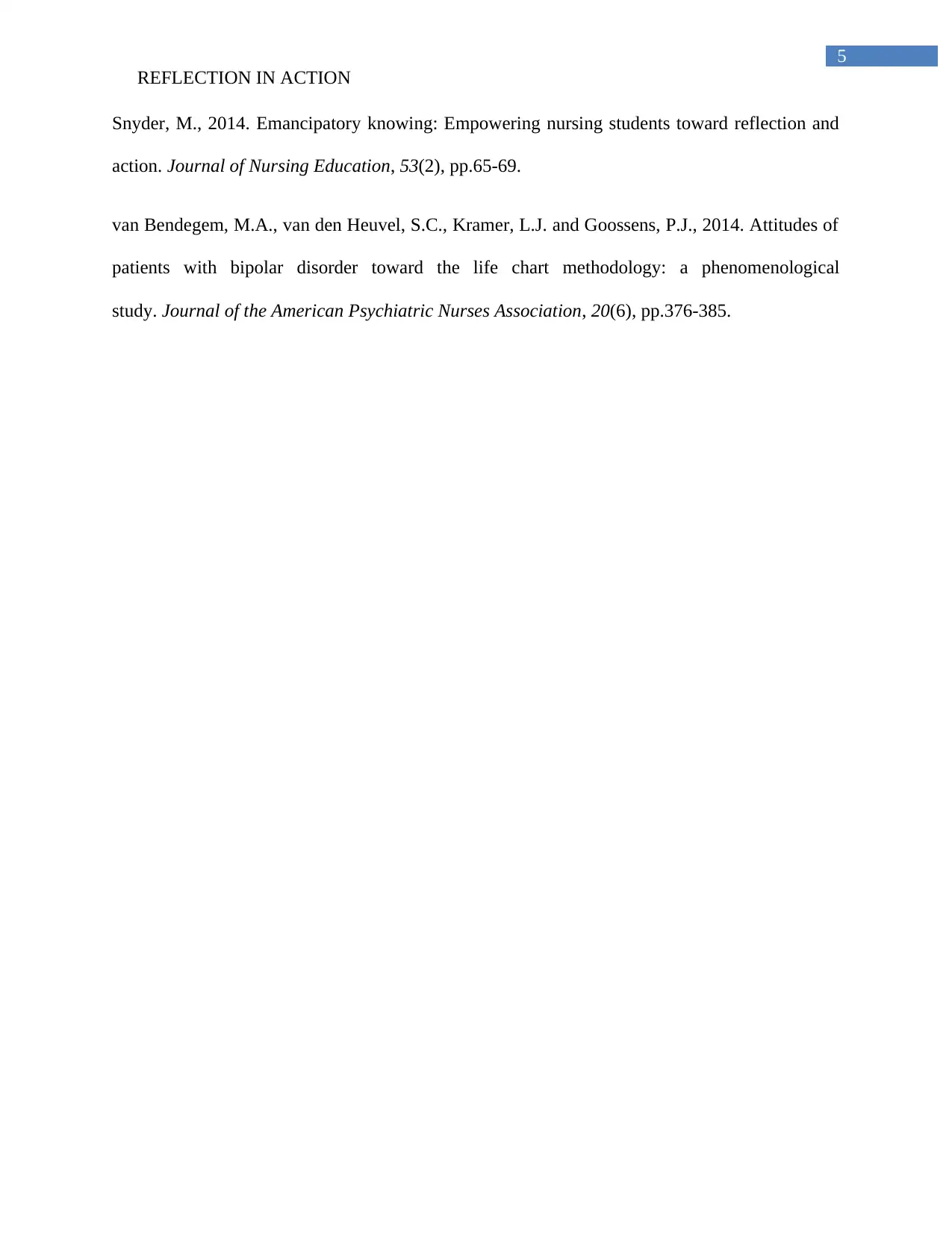
5
REFLECTION IN ACTION
Snyder, M., 2014. Emancipatory knowing: Empowering nursing students toward reflection and
action. Journal of Nursing Education, 53(2), pp.65-69.
van Bendegem, M.A., van den Heuvel, S.C., Kramer, L.J. and Goossens, P.J., 2014. Attitudes of
patients with bipolar disorder toward the life chart methodology: a phenomenological
study. Journal of the American Psychiatric Nurses Association, 20(6), pp.376-385.
REFLECTION IN ACTION
Snyder, M., 2014. Emancipatory knowing: Empowering nursing students toward reflection and
action. Journal of Nursing Education, 53(2), pp.65-69.
van Bendegem, M.A., van den Heuvel, S.C., Kramer, L.J. and Goossens, P.J., 2014. Attitudes of
patients with bipolar disorder toward the life chart methodology: a phenomenological
study. Journal of the American Psychiatric Nurses Association, 20(6), pp.376-385.
⊘ This is a preview!⊘
Do you want full access?
Subscribe today to unlock all pages.

Trusted by 1+ million students worldwide
1 out of 6
Related Documents
Your All-in-One AI-Powered Toolkit for Academic Success.
+13062052269
info@desklib.com
Available 24*7 on WhatsApp / Email
![[object Object]](/_next/static/media/star-bottom.7253800d.svg)
Unlock your academic potential
Copyright © 2020–2025 A2Z Services. All Rights Reserved. Developed and managed by ZUCOL.





